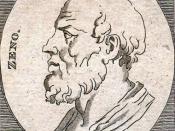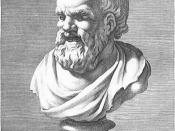1. Atomism was devised by Leucippus and his student Democritus. Democritus was born about 460 B.C., which makes him about 40 years younger than Anaxagoras, and about 10 years younger than Socrates.
Atomism is the final, and most successful, attempt to rescue the reality of the physical world from the fatal effects of Eleatic logic by means of a pluralistic theory. (Guthrie, vol. 2, p. 389)
2. Overview of atomism:
1. Imagine each atom, taken by itself, as a Parmenidean unit. Each is indivisible. There is no differentiation between one part of an atom and another part. There is no empty space within an atom - it's a plenum.
2. Thus, the atomists tried to agree with Parmenides about everything except the number of real beings.
3. Comparison with Anaxagoras and Empedocles: theirs was a qualitative pluralism. The atomists offered a quantitative pluralism.
3. Properties of atoms: each atom is uniform, homogeneous, colorless, tasteless, and indivisible.
(We will inquire in a moment into precisely the sense in which atoms are indivisible.)
Atoms have size, shape, and (perhaps) weight. And they can move. That is, atoms have (what have come to be called) primary qualities. As for such secondary qualities as color, taste, etc., atoms do not have them - an atom cannot be yellow, or salty.
4. Democritus's atomistic universe: atoms move about in the void (empty space), collide, attach to others to form compounds. These compounds can have secondary qualities, but such qualities can be reduced to the primary qualities of their component atoms. Cf. 20=A129:
He makes sweet that which is round and good-sized; astringent that which is large, rough, polygonal, and not rounded; sharp tasting, as its name indicates, that which is sharp in body, and angular, bent and not rounded; pungent that which is round and...


